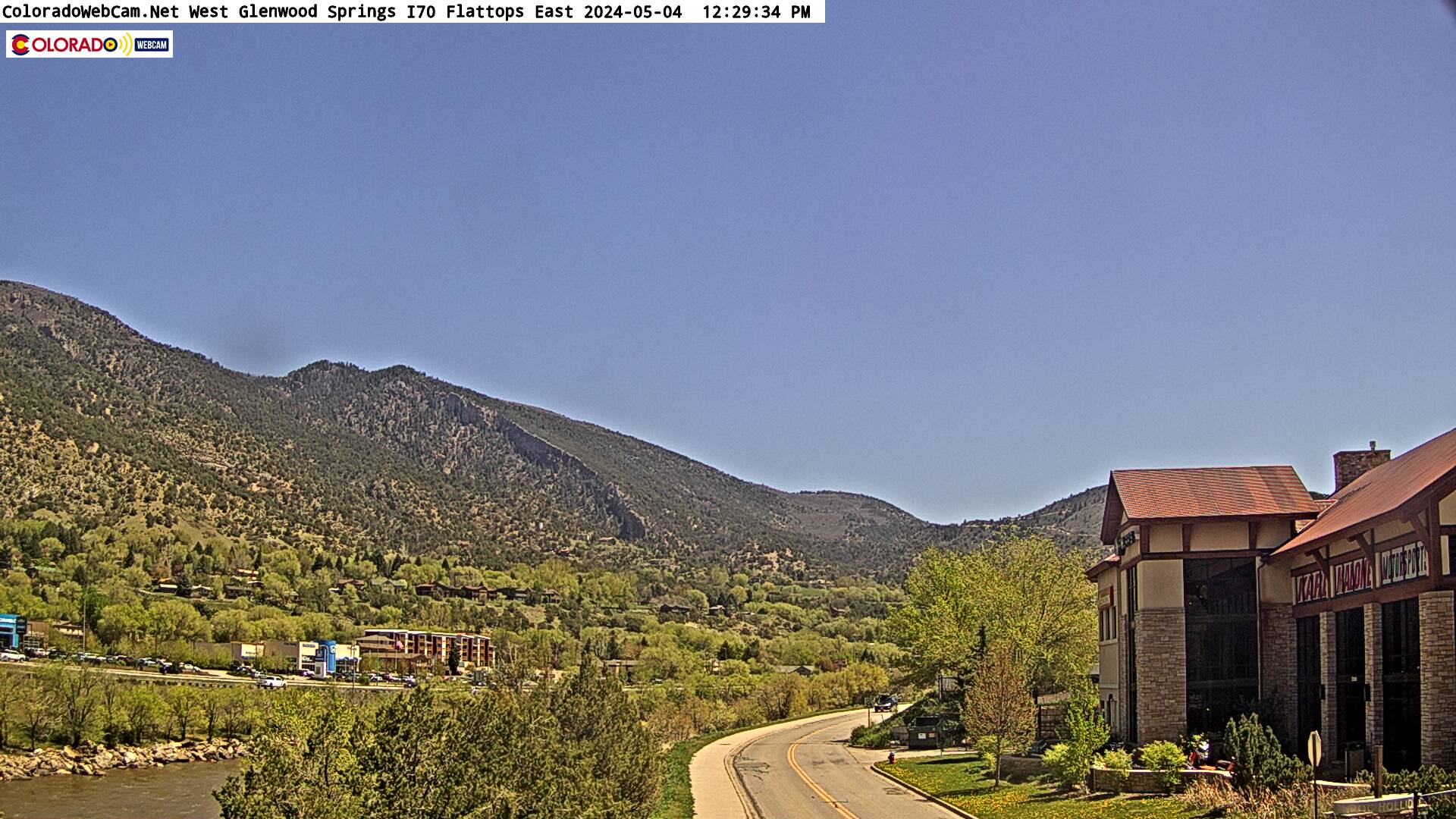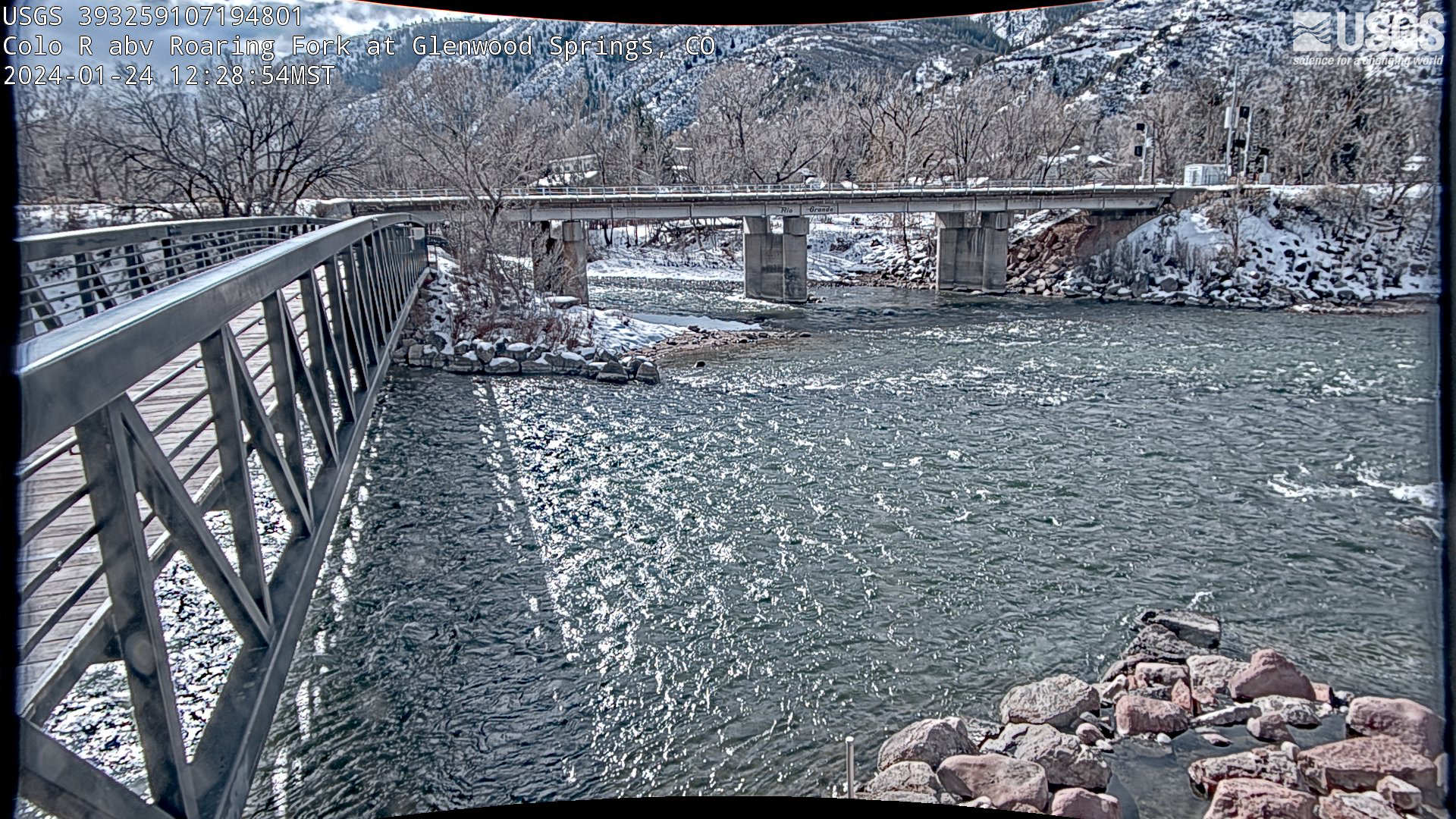Glenwood Springs, Colorado Weather Cams
Glenwood Springs Pool Cam 1
Glenwood Springs Pool Cam 2
Glenwood Kayak Park Up River East Off-ramp Roundabout Cam (via Coloradowebcam.net)

Glenwood Kayak Down River West Cam 1 (via Coloradowebcam.net)

Glenwood Kayak Down River West Cam 2 (via Coloradowebcam.net)

Glenwood Kayak Down River West Cam 3 (via Coloradowebcam.net)

GWS Midland Ave Colorado River Cam (via Coloradowebcam.net)

GWS Two Rivers Park Midland Cam (via Coloradowebcam.net)

Rifle Webcam HWY 13 I70 Colorado River Cam (via Coloradowebcam.net)

HWY 82 Cattle Creek Down Valley Cam (via Coloradowebcam.net)

West Glenwood Springs (via Coloradowebcam.net)

West Glenwood Springs (Midland Ave. Flattops) (via Coloradowebcam.net)

USGS Cam Colorado River above Roaring Fork

Glenwood Springs, Colorado: Hot Springs, Railroads, and the Healing Heart of the Rockies
Glenwood Springs, Colorado Weather Cams. Nestled at the confluence of the Roaring Fork and Colorado Rivers, Glenwood Springs is a town where geothermal wonders, frontier grit, and Victorian elegance converge. Known today for its world-famous hot springs and dramatic canyon scenery, Glenwood Springs has long been a crossroads—first for Indigenous peoples, then for miners, railroaders, and health seekers. Its story is one of transformation, from a rough-and-tumble settlement called Defiance to a refined mountain resort that drew presidents, outlaws, and visionaries alike.
Indigenous Roots and Sacred Waters
For centuries before European contact, the area now known as Glenwood Springs was part of the ancestral homeland of the Ute people, particularly the Parianuche and Yampa bands. The Utes were nomadic hunter-gatherers who followed seasonal game and returned each winter to soak in the mineral-rich hot springs, which they believed had healing properties. The springs were part of a sacred landscape, and the surrounding valleys and canyons were vital to their cultural and spiritual life.
Despite an 1868 treaty that preserved Ute hunting grounds in the region, white settlers began encroaching on the land in the 1870s. Tensions escalated, culminating in the forced removal of the Utes to reservations in Utah by the early 1880s.
From “Defiance” to Glenwood Springs
The first permanent white settlement in the area was established in 1879 and was aptly named Defiance—a rowdy camp of tents, saloons, and brothels built on land still technically part of the Ute reservation. The town’s name reflected its rebellious spirit, but it didn’t sit well with everyone. Isaac Cooper, one of the town’s founders, renamed it Glenwood Springs in 1883 at the urging of his wife Sarah, who longed for a more genteel name reminiscent of her hometown in Iowa.
The town was officially incorporated in 1885 and quickly began to attract attention for its natural hot springs and scenic location. The arrival of the Colorado Midland Railway in 1887 and the Denver & Rio Grande Western Railroad in 1887 turned Glenwood Springs into a transportation hub and a destination for travelers seeking rest and rejuvenation.
The Rise of a Resort Town
The late 19th century saw Glenwood Springs blossom into a premier health and leisure resort. In 1888, entrepreneur Walter Devereux built the Glenwood Hot Springs Bathhouse, enclosing the largest hot springs pool in the world. To complement the bathhouse, he opened the Hotel Colorado in 1893—a grand, Italianate structure designed to attract wealthy visitors and dignitaries.
The hotel quickly gained fame. President Theodore Roosevelt stayed there during hunting trips and even used it as a summer retreat, earning it the nickname “The Western White House.” The hotel’s lavish halls and mineral baths drew celebrities, politicians, and socialites from across the country.
Doc Holliday and the Town’s Rougher Edge
Despite its refined aspirations, Glenwood Springs retained a touch of the Wild West. One of its most famous residents was John Henry “Doc” Holliday, the legendary gunslinger and dentist best known for his role in the Gunfight at the O.K. Corral. Suffering from tuberculosis, Holliday came to Glenwood Springs in 1887 hoping the hot springs would ease his symptoms. He died in 1887 at the age of 36 and is buried in Linwood Cemetery, overlooking the town.
Another notorious figure, Kid Curry—a member of Butch Cassidy’s Wild Bunch—is also buried in the same cemetery, adding to the town’s outlaw lore.
Innovation and Infrastructure
Glenwood Springs was an early adopter of hydroelectric power. In 1897, electric lights were installed inside the Fairy Caves on Iron Mountain, making them one of the first caves in the U.S. to be electrically lit. In 1909, the Shoshone Hydroelectric Plant began operating in Glenwood Canyon, securing some of the most senior water rights on the Colorado River—a legacy that still influences water policy today.
The town’s location along the Colorado River also made it a key stop on the Midland Trail, one of the first transcontinental automobile routes. Later, Interstate 70 would follow the same corridor, threading through the dramatic Glenwood Canyon.
Garfield County and the Roaring Fork Valley
Glenwood Springs is the county seat of Garfield County, established in 1883 and named after President James A. Garfield. The county encompasses a diverse landscape—from the high mesas near Rifle to the alpine valleys of Carbondale and Marble. The Roaring Fork Valley, stretching southeast from Glenwood Springs to Aspen, has long been a vital corridor for trade, agriculture, and recreation.
The valley’s economy evolved from mining and ranching to tourism and conservation. Today, it is one of the most affluent and ecologically conscious regions in the state, with Glenwood Springs serving as its western anchor.
War, Fire, and Renewal
During World War II, the Hotel Colorado was repurposed as a Navy convalescent hospital, treating wounded sailors in a tranquil mountain setting. After the war, the hotel returned to civilian use, though it fell into disrepair before being restored in the late 20th century.
In 1945, the Hotel Glenwood, where Doc Holliday died, was destroyed in a fire—reportedly caused by a boiler explosion. Six people perished, and the site now houses a retail store that includes a small museum dedicated to Holliday’s life.
Glenwood Springs Today: Wellness and Wonder
With a population of just under 10,000, Glenwood Springs remains a small town with outsized appeal. Visitors flock to soak in the Glenwood Hot Springs Pool, explore the Glenwood Caverns Adventure Park, and raft the whitewater of the Colorado River. The town’s walkable downtown, historic architecture, and vibrant arts scene make it a year-round destination.
Glenwood Springs continues to balance preservation and progress. It honors its Indigenous roots, celebrates its frontier past, and embraces a future grounded in wellness, sustainability, and community.
For more information, visit the Glendwood Springs, Colorado official website.
